Ressence Type 2A/2G: Is This Electronic-Mechanical Hybrid Timepiece The Future Of Mechanical Watchmaking?
Science fiction is full of promises for future technologies, from hyper-advanced teleportation down to the simple automatic sliding door. Depending on which genre of science fiction you look at, the technologies could be accurately predicted developments of upcoming products or far-future fantasies that are unlikely to come to pass unless our understanding of physics is completely ignorant of the underlying truth.
Either way, some future technologies in science fiction have been developed and found their way into our everyday lives – like super-smart computers in our pockets and instantaneous video communication. However, there are often very cool ideas that the broader public gets excited about that never materialize. Or when they do the reality is underwhelming to say the least.
I remember watching Back To The Future Part II and dreaming of self-tying shoes and hoverboards only to grow up and be disappointed with Crocs and two-wheeled “hoverboards” that caught fire from faulty batteries. Not everything can live up to initial expectations, and in the world of product development we often see concepts that promise the stars and end up delivering peanuts.
This isn’t surprising when you understand the nuances of manufacturing versus the ideals of concepts and prototypes. But the repeated disappointment can become disheartening – that is, until a concept comes along that delivers when it finally gets to production.
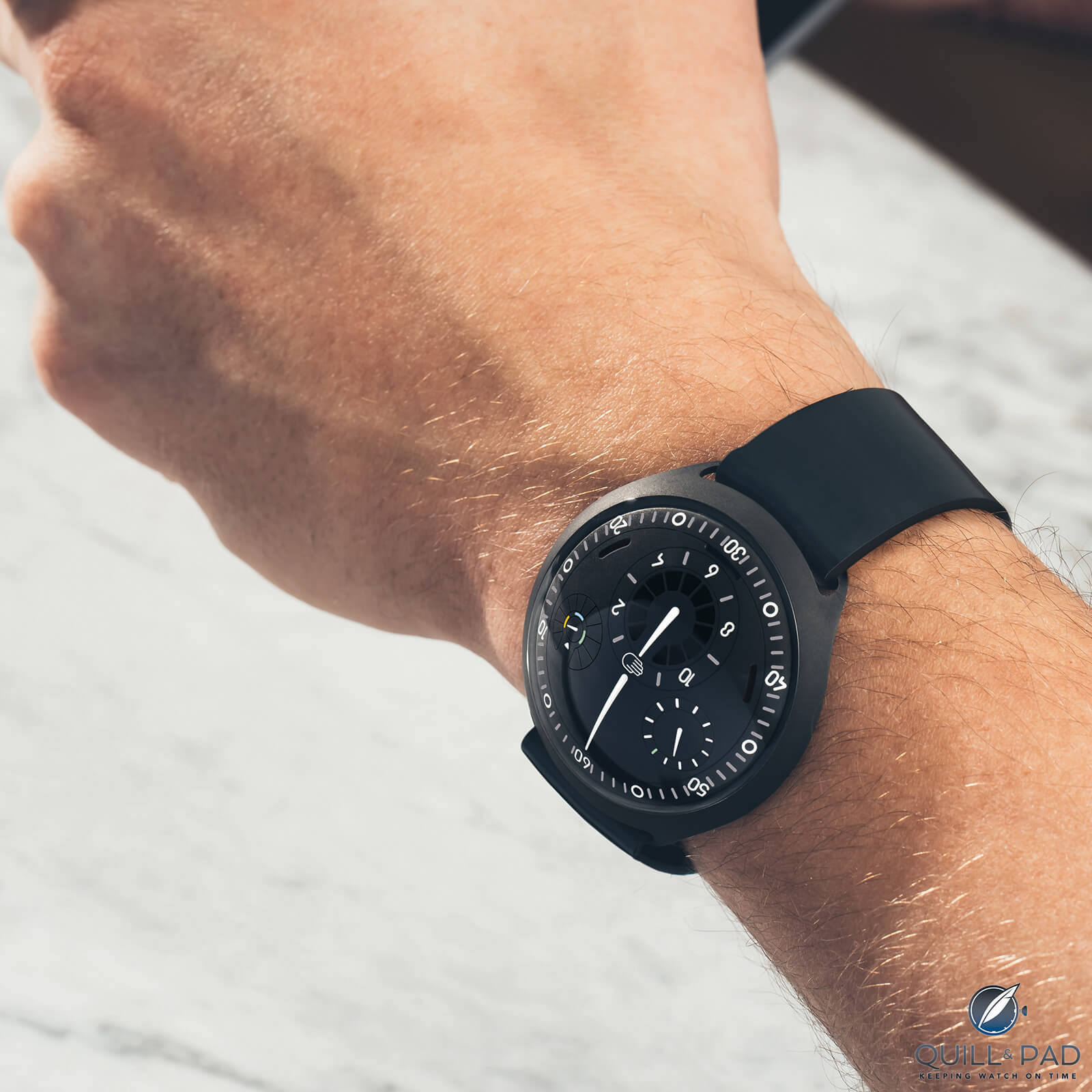
Ressence Type 2A on the wrist
A great example in watches is the Ressence Type 2, the production version of the extremely cool e-Crown concept that debuted at SIHH in 2018.
When the first Type 2 production pieces arrived in early 2019, we didn’t see a watered-down, basic version of the original concept but rather a watch that had ironed out all the kinks and fully delivered on the promises made by the shiny concept first seen a year prior.
Let’s dig into the Ressence models Type 2A and 2G and remind ourselves what made the e-Crown concept incredible in the first place, along the way discussing where the Type 2 sits in the world of intelligent, connected watches.
Ressence Type 2A and 2G
The original concept was named the Type 2 e-Crown, but now that it has become a production watch, the “e-Crown” has turned into the collection name and each model now has a letter indicating the case finish.
Type 2A is the anthracite-colored dial and case, a very dark grey (nearly black), while Type 2G has a medium grey finish. Aside from different straps and the addition of some new openings on the dial for more photovoltaic charging, the production version is nearly identical to the e-Crown concept watch with most of the changes happening to the PCB components with the e-Crown system to work out functional issues with the concept pieces.
With concept cars, it is typical for most of the features and details on the concept or prototype to be weeded out once the design is optimized for manufacturing. The Type 2 is the complete opposite as it has retained pretty much every single thing and has only improved in function (and based on early comments about the concept prototypes, ease of assembly has been addressed as well).
The Type 2A and 2G are sort of like augmented Type 1 models in a way, with similar concepts for the mechanics of the ROCS (Ressence Orbital Convex System) and the same base movement. The case didn’t really change between the first e-Crown concept and the Type 2, with the biggest visual adjustment coming from the addition of photovoltaic windows in the hour dial. Otherwise it remains true to the concept pieces.
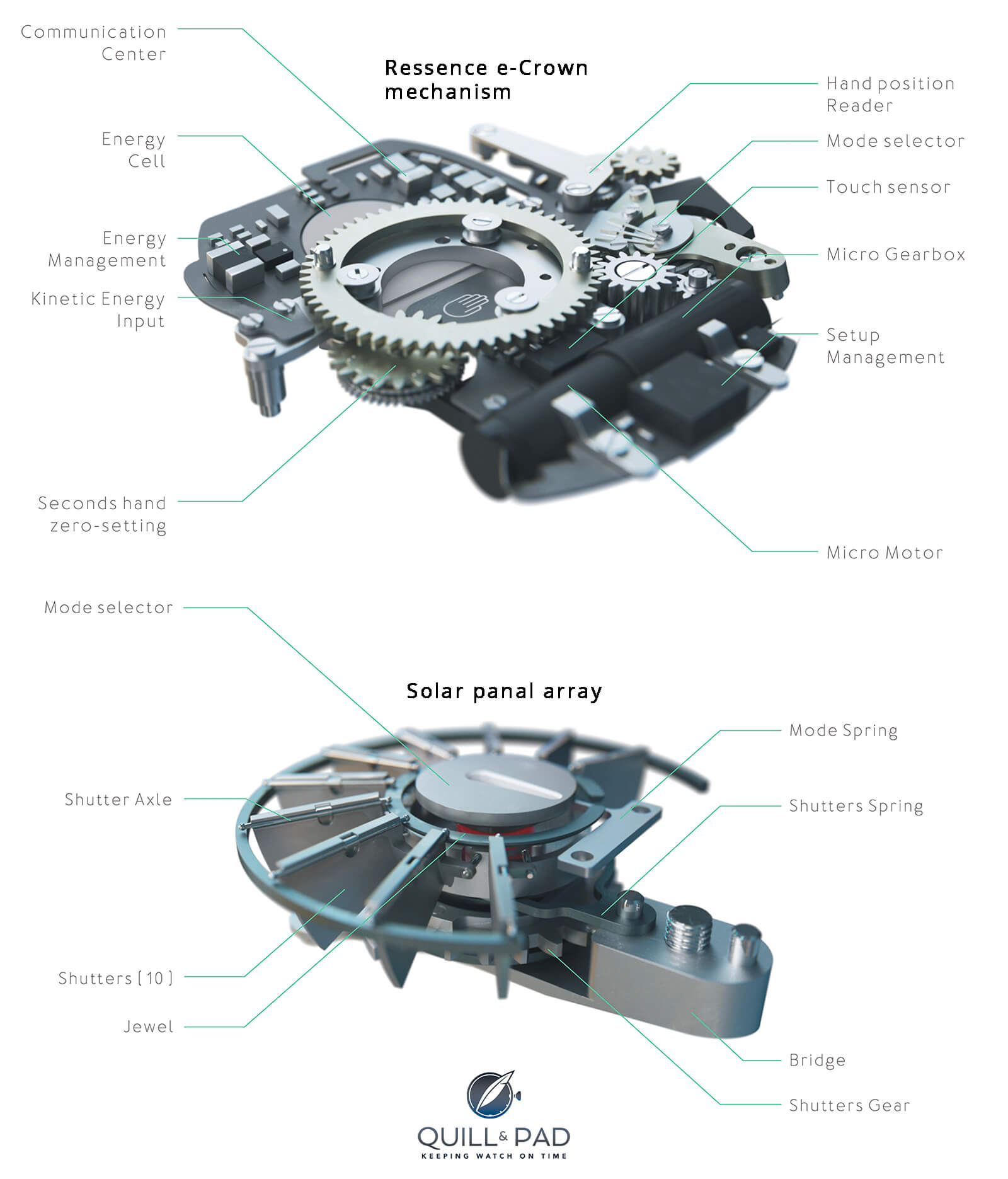
Ressence e-Crown mechanism (top image) and solar panel shutters array (bottom image)
Knowing that the watch is not lesser, but instead even better, than the prototypes and that improvements have been made for production, the Type 2 is, in my book, the ultimate intelligent mechanical watch. I don’t call it a smart watch because that lacks description of what it truly is and implies that it does a lot of things outside of being a watch. This is no smartwatch, and that is probably why I like it so much.
It is the incredible mechanics of Ressence with a cherry on top, so to speak.
Support, not control
Let me say it loud and clear: Type 2 is a fully mechanical watch. It can be set manually and will operate its entire life as a 100 percent mechanical movement. The base ETA 2892 caliber has been customized to drive the entire watch from the minute axle and is pretty much independent of the ROCS dial display mechanism, which is functionally independent of the e-Crown electro-mechanics.
The original concept of the Type 1 (all derived from Series 1, the originator of this strategy) was to have an independent dial mechanism that did away with hands and the traditional crown to change how we interact with time. The dial was the big innovation at the beginning of the brand.
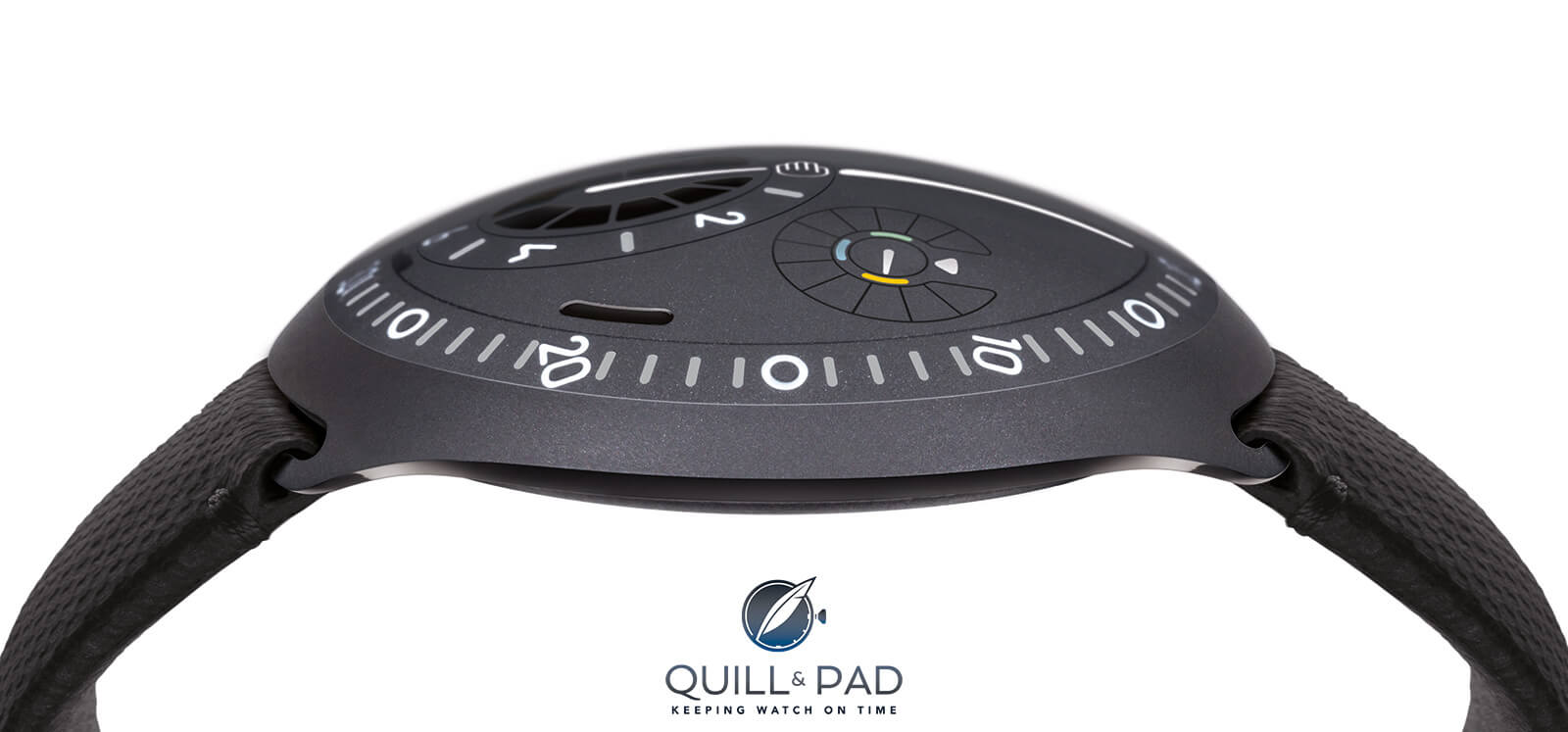
Ressence Type 2 side on and curves galore
This was not easy as the dial of any Ressence watch is rather unique because it consists of domed subdials inset into a larger domed dial, all traveling 360 degrees thanks to an internal planetary gear system (see specifics on the assembly of the domed dial in How Do They Do That? The Ressence Type 3). The ROCS assembly is a difficult mechanism to make as each dial is tilted off of vertical between 9.75 and 17 degrees. Additionally, the Type 2 sees accommodation of the new e-Crown electronics so it can run fully mechanically, but also be manipulated by the electronic system as well.
The watch can be set and operated without the e-Crown system ever turning on, in fact an option to turn it off also exists. But the entire point of the Type 2 is to be a fully mechanical watch that can set itself. Having the e-Crown system on allows setting two time zones and having the watch adjust the time once a day to the nearest minute based on the reference time you set manually (via the lever on the rear of the watch) for the first time zone. That is the e-Crown Lite mode.
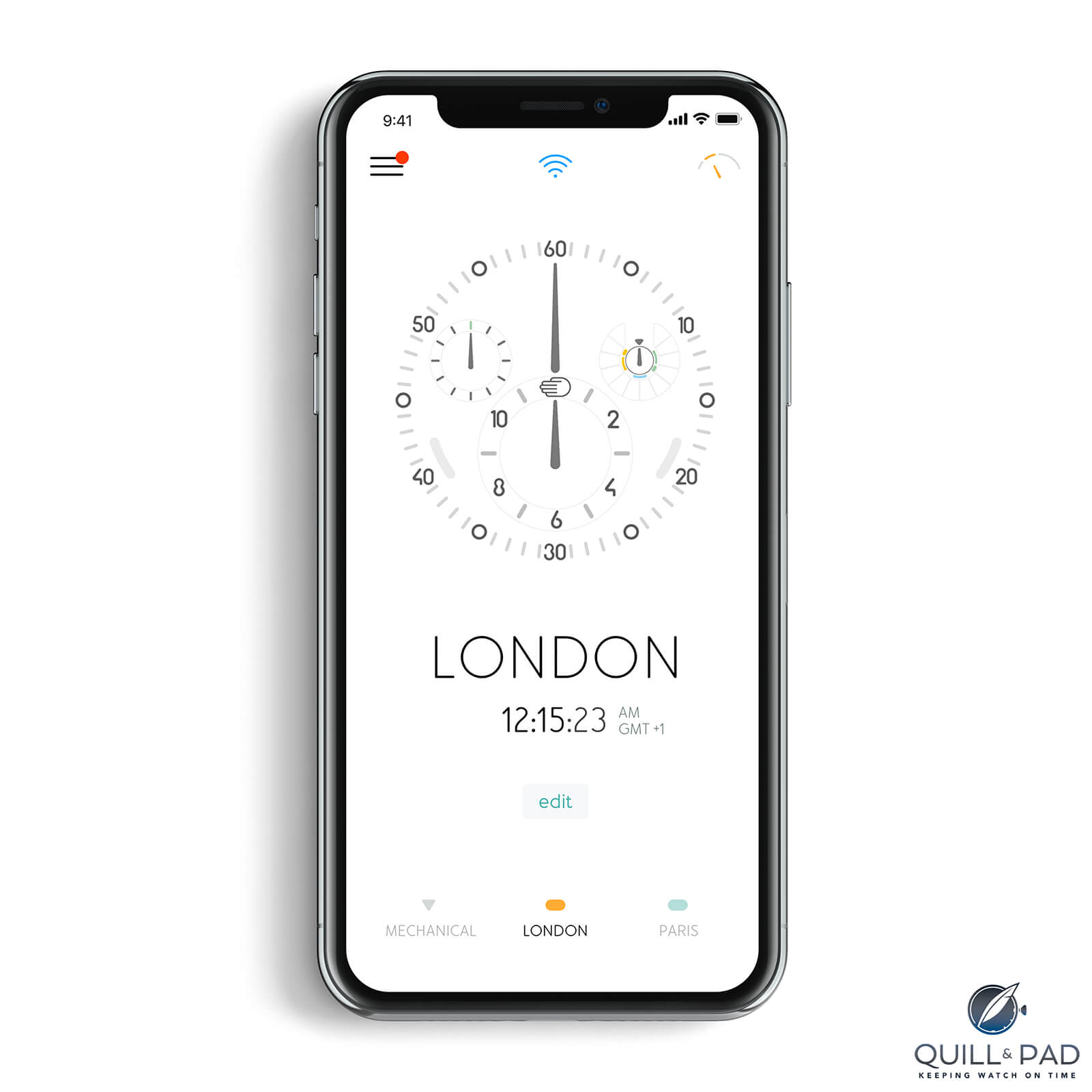
There’s an app for that! Ressence’s e-Crown app sets and synchronizes the mechanical Type 2 watch it is paired with
Switching to full e-Crown mode necessitates use of a mobile app and Bluetooth to add additional time zones (again, still technically based on the manually set reference time) and have the e-Crown not only adjust the time once a day but adjust to the nearest second instead of minute.
But, for 99.99 percent of the day, the Type 2 is a fully mechanical Ressence watch. If you don’t use the app and simply go with e-Crown Lite, an internal accelerometer will register your finger taps on the crystal to interact with the mechanism.
Point of note: when I first wrote about the e-Crown concept just after SIHH 2018 I mistakenly said that the crystal was touch sensitive but that is incorrect, it simply provides a surface to tap that the onboard accelerometer can easily recognize and further reduces the integration of electronics into the watch.

Ressence Type 2A
Perspective of time
Three years after first seeing the e-Crown concept and coming up on almost two years since the production models first debuted has allowed some perspective on the place of this watch in the industry and the ability to assess the reception and misconceptions about the Type 2. When this watch launched, I was rightfully excited because Ressence is one of my favorite brands and always seems to be thinking laterally compared to most others.
This is largely due to Ressence founder Benoît Mintiens not being a watchmaker or watch designer by training but instead an industrial designer working in product development (the industry I work in as well, specializing in prototyping). This gave him the ability to look at watches with a new lens, so it is less surprising that he has such unique solutions for his watch designs.
The e-Crown concept stood out for being an honest integration of modern technology with classic watchmaking, not seeking to change what has come before but to improve it in some tangible way.
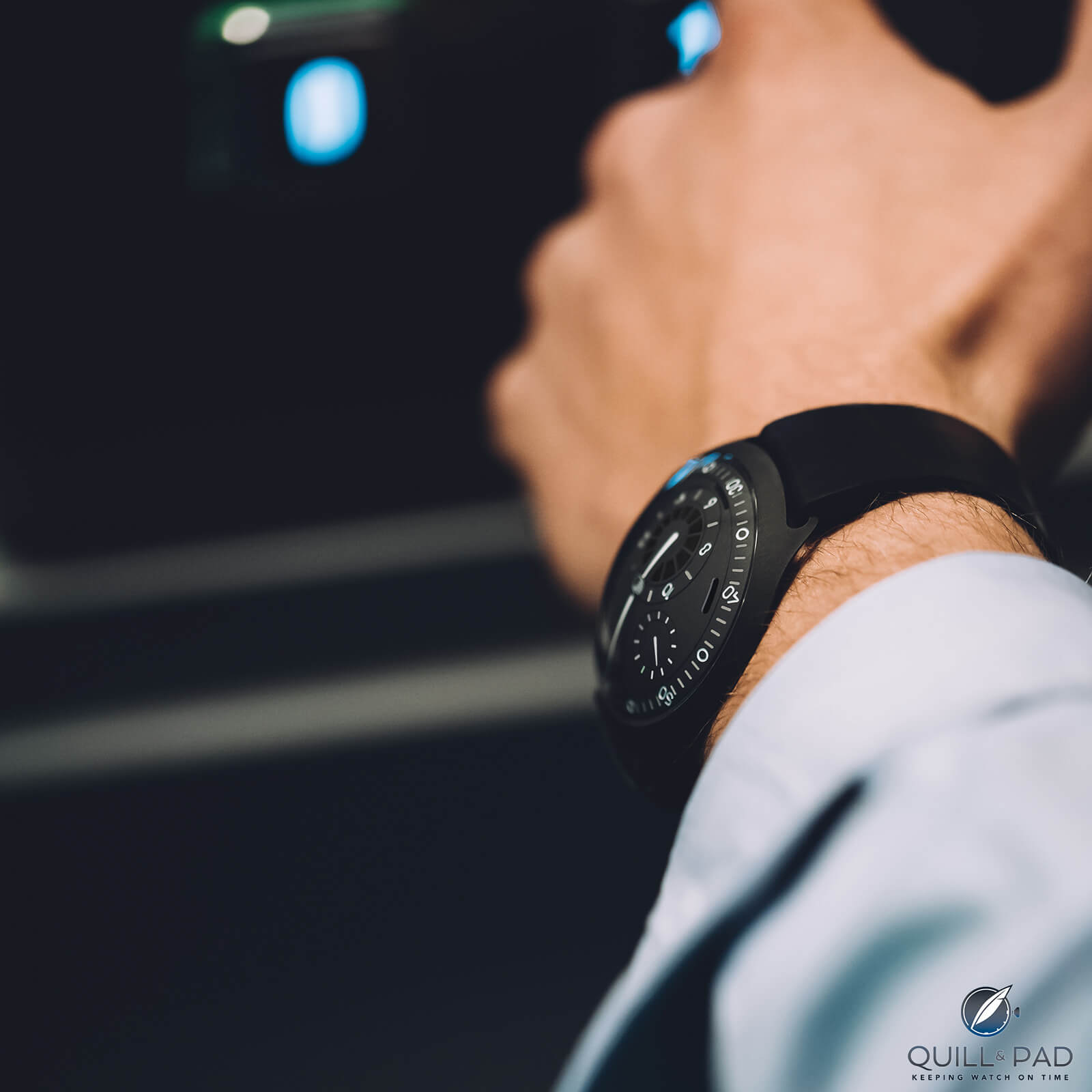
Ressence Type 2A on the wrist
This still rings true today, three years later, and I am probably even more convinced that the Type 2 could be a standard bearer for practical combinations of future tech with classic mechanics. The fact that the watch is not built around the concept of obsolescence and the components of the e-Crown should last for years is a testament to the idea that this isn’t an iPhone designed to be replaced every year or two. It is built like any other mechanical watch to last for years before even needing service (the app can tell you when it needs service), and the e-Crown system is largely an addendum to its functionality.
I have seen people opine against the inclusion of the electronics, asserting that it simply ruins a good thing and guarantees it to become obsolete and make the watch useless. This is the farthest thing from the truth. The system is deceptively simple in its function and since it doesn’t affect the operation of the movement at all except in the few seconds where it is adjusting the time (the same way you would adjust via a traditional crown), it can hardly be detrimental.
In fact, it clearly demonstrates that we can add interesting and useful functions to things without compromising the original if we focus in on a specific issue to address. Some WIS love interacting with their watch every day, winding it, setting the time, getting that tactile engagement. But those people probably buy classic manual winding watches and prefer the relationship with the watch over adding ease-of-use functionality.
I love classic watches the same way I love historical tools, but I will still choose a CNC milling machine over a manual milling machine pretty much every day.
The Type 2 is for those WIS who love advances in technology but still have appreciation for the classic and traditional. People might ask, “Why don’t you just buy a Seiko Astron if you want a watch that updates itself?” not realizing that isn’t the point of the timepiece in the first place.
Like all other Ressence watches, Type 2 embraces mechanical watchmaking but isn’t bound to color within the lines of traditional watchmaking.
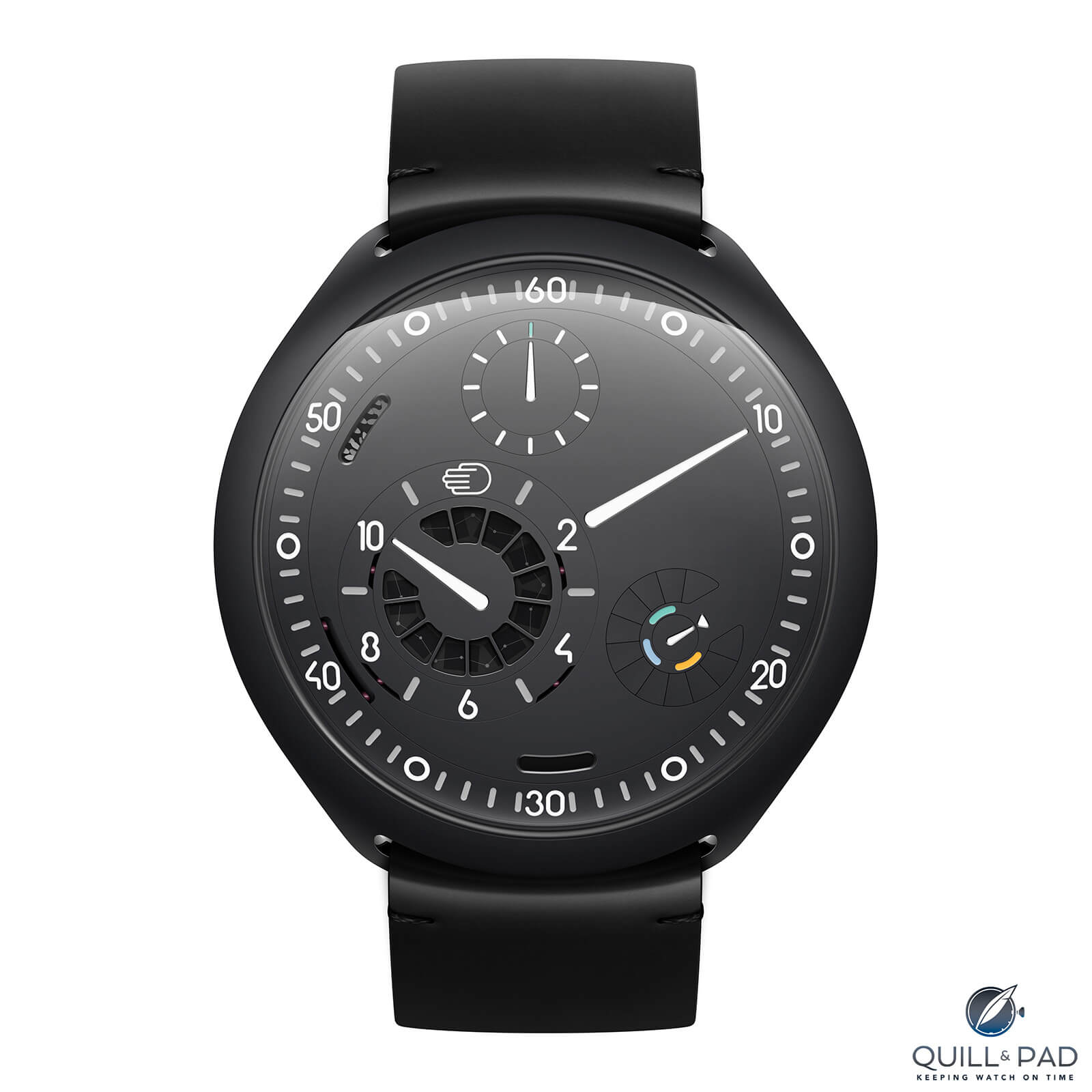
Ressence Type 2
Type 2A is entered into the 2020 Grand Prix d’Horlogerie de Genève (GPHG) in the Mechanical Exception category against five other watches that are completely mechanical but exist only as the result of advanced technologies and mechanical or material innovations.
I think the Type 2A is an excellent participant in that category and demonstrates the levels of mechanical exception possible when you think in ways others might overlook. Knowing how Mintiens likes to rethink fundamental aspects of how we engage with objects, I expect that the Type 2 won’t be the last idea that uses advancements of today to augment concepts from the past.
As I wait to see what comes next, let’s break the Type 2 down!
- Wowza Factor * 9.45 A fully mechanical watch that has a little helper to make setting the time easier, you betcha!
- Late Night Lust Appeal * 94.5» 926.728m/s2 If all I did was play with the e-Crown, I could be up for days. This watch has all sorts of late-night lusting happening!
- M.G.R. * 68.4 While the base caliber is a modified ETA 2892, the ROCS module and e-Crown are entirely worthy of a heaping pile of geek admiration!
- Added-Functionitis * Moderate The watch features a second time zone, which is rather useful, but with the addition of the e-Crown system there is so much that you will probably want to invest in extra-strength Gotta-HAVE-That cream!
- Ouch Outline * 11.4 I slipped with a dull knife! They say you want a sharp knife so that when you cut yourself it is a clean wound that will heal fast. Well, based on how ragged my cut from an extremely worn-down utility knife was, I concur with that statement. Though I would probably do it again if it meant getting a Type 2 on my wrist!
- Mermaid Moment * Tap, tap, tappy! Just tap on that sapphire crystal and I will start tapping the numbers for the church down the road to reserve a weekend in August!
- Awesome Total * 914.2 First take the number of components (479) and multiply by the amount of energy that the e-Crown system uses in joules per day (1.8), then add the weight of the watch in grams (52) for a groundbreaking awesome total!
For more information, please visit www.ressencewatches.com/watches/type-2.
Quick Facts Ressence Type 2A and 2G
Case: 45 x 12 mm, titanium with PVD coating
Movement: modified automatic ETA Caliber 2892/A with patented ROCS module and patented e-Crown mechanism, 36 hours power reserve, 28,800 vph/4 Hz frequency
Functions: hours, minutes, seconds; e-Crown functions: mode selector, second time zone, world time, mechanical power saver, self-setting, time monitoring
Price: 42,500 Swiss francs
You may also enjoy:
Ressence Type 2 e-Crown Concept: The Right Combination At The Right Time (With Videos)
Ressence Type 2 E-Crown Explained By Founder Benoît Mintiens (Video)
Leave a Reply
Want to join the discussion?Feel free to contribute!



Such a waste.. The tiny hand on the dial.. So cheap; this is not watchmaking.. No
Your totally right.
I 100% disagree with your assessment, but it’s nice to know that it isn’t to your tastes. Thanks for your comment!
When not connected to the phone, how does the e-crown keep time? There must be some sort of clock as part of the electronics (quartz). They seem to not want to bring that up.
The mechanical part of the watch keeps time.
As Elizabeth mentioned the mechanical movement is what keeps time.
The e-Crown has a component similar to the CMOS chip on a computer which uses extremely low voltage to keep a reference time but isn’t constantly tracking time like a quartz movement. So the Type 2 does not have a quartz or digital watch onboard, it simply has a basic reference time that can be used to verify that the watch is maintaining accurate time if desired, although this is not necessary for the watch to function.
This reference time, combined with the onboard electronics, is good enough to act as a baseline for the e-Crown Lite mode which simply adjusts the time to within a minute of the reference time once per day. For more accurate (to the second) time adjustment, you need to use the app. This system is in the same vein as the Urwerk EMC in that is has electronic sensors that detect what the mechanical movement (in this case the time display) is doing that then allows the user to decide if it wants to let an external mechanism make an adjustment.
It really is the combination of fully traditional watchmaking with the most minimal intrusion of modern electronics for a useful function.
Thank you for the review. Since this watch was announced, I’ve followed it closely, but I cannot decide if it is worth the money. On one hand, you have very clever self-sustaining electronics, and an attractive form factor, but on the other, you’ve got a pretty ordinary movement and obsolescence issues. This for the rough price of an haute chronograph or annual calendar.
Overall, I’d very much like one, as it seems to me to be a well thought out mix of horology and technology, but I think my blood would freeze in my hand as I reached for my credit card…
I read the article. This is a mechanical watch ( old technology) combined with electronics. And, if you want it accurate, connected with a mobile phone. Why all this , when a phone can deliver?
On the other hand, what is the advantage of this in front of Seiko Astron?